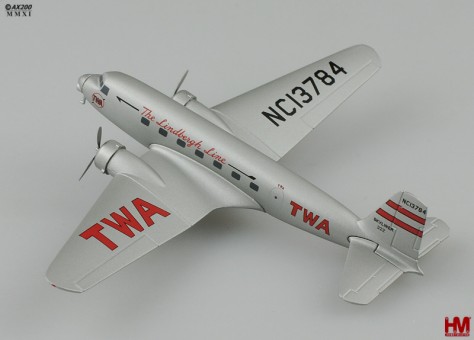You have no items in your shopping cart.
TWA Douglas DC-2 1/200 "The Lindbergh Line," 1935.
Hobby Master Douglas DC-2 1/200 Die Cast Model: TWA "The Lindbergh Line," 1935.
Details
Douglas DC-2 1/200 Die Cast Model: TWA "The Lindbergh Line," 1935.
NC13784
1/200 scale die-cast metal with minimal use of plastic.
All markings are tampo (pad) applied, no decals to discolor or flake.
Free-spinning propellers.
Rolling wheels.
Landing gear can be removed or added.
Model comes with a display stand.
A brief history of the aircraft type and the airline is supplied with each model.
The DC-2 (Douglas Commercial 2) was developed to compete with Boeing’s 247. With the
success of the DC-1, Douglas decided to build on it. The two Douglas aircraft had similar
shapes but the DC-2 had more powerful engines that made it capable of longer flights at
faster speeds. The DC-2 was two feet longer and could carry two more passengers.
The DC-2 (Douglas Commercial 2) was developed to compete with Boeing’s 247. With the
success of the DC-1, Douglas decided to build on it. The two Douglas aircraft had similar
shapes but the DC-2 had more powerful engines that made it capable of longer flights at
faster speeds. The DC-2 was two feet longer and could carry two more passengers. The DC-
2 was an immediate success and became the first Douglas airliner to enter service with a
non-U.S. airline. Between 1934 and 1937 Douglas built 156 DC-2’s.
Douglas DC-2 NC13784 began service with TWA (Trans Western Airlines) on May 18,
1934. The airline started as TAT (Transcontinental Air Transport) that called their self “The
Lindbergh Line”. After a merger with Western Air Express the name became Trans Western
Airlines (TWA). In 1950 the “W” was changed to “World”. On April 22, 1942 NC13784 was
sold to Northeast Airlines but on July 22, 1942 it was impressed by the U.S. military as C-
32A 42-65579. On November 3, 1944 the aircraft was sold as surplus to TACA Airlines.
Specifications Douglas DC-2
First flight - May 11, 1934
Number produced – 156
Crew – 2 or 3
Dimensions
Length – 62.5 ft (19.1m)
Wingspan – 85 ft (25.9 m)
Height – 15 ft 10 in (4.8 m)
Weights
Empty – 12,455 lbs (5,560 kg)
Maximum – 18,560 lbs (8,420 kg)
Performance
Engines – 2 x Wright Cyclone GR-F53 9-cylinder radial producing 730 hp (540 kW) per
engine
Maximum speed – 210 mph @ 6,800 ft (338 km/h)
Range – 1,085 miles (1,750 km)
Service ceiling – 22,750 ft (6,930 m)
Rate of climb – 1,030 ft/min (310 m/min)
Additional Info
-
Stock#HL8001
-
BrandHobby Master
-
Country of ManufactureN/A
-
AircraftDouglas DC-2
-
AirlineTWA
-
RegistrationNC13784
-
MaterialDie-cast Metal
-
Scale1:200
-
Dimensions (L x W)N/A
Warning: Choking Hazard!
Contains small parts. Not a toy. Not for children under 3 years.
Customer Reviews
- Hobby Master 200 Douglas DC-2 Die Cast Model: TWA "The Lindbergh Line," 1935. NC13784
-
Douglas only made 156 DC-2s before the upgraded DC-3 was brought into production. The DC-3 was about two feet longer then the DC-2 and could hold a couple of extra passengers. The DC-2 was set up for 14 passenger seats. NC1378 was used by TWA on their first coast to coast flight from New York City to Los Angles. Here you will find an image of the aircraft: http://nycaviation.com/2010/10/on-this-day-in-aviation-history-october-25th/. This picture drove me a bit crazy for a while. If you look you can see two antenna's not one like the Hobby Master model has. I looked on A-net and found 250 plus pictures of all DC-2s and then sorted the list of all DC-2s that flew for TWA. TWA had variants that had no antenna, one antenna and two antennas. I guess it would have been nice of HM had seen the picture and did the model with two instead of one antennas. The model features a nose with the landing lights on it. The DC-3 moved the lights to the wings. The picture of the plane shows that HM placed the colors and fonts properly on the model. They have done a reasonable job with the model seams. I hope they milk this mould and give us a bunch more DC-2s. (Posted on 3/7/2011)




